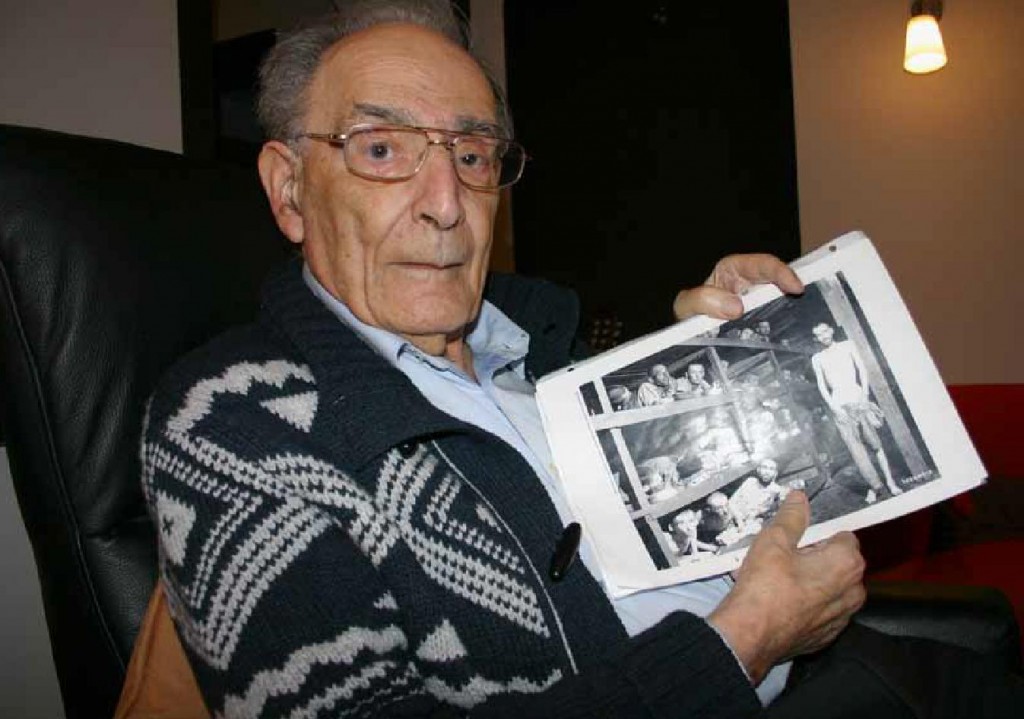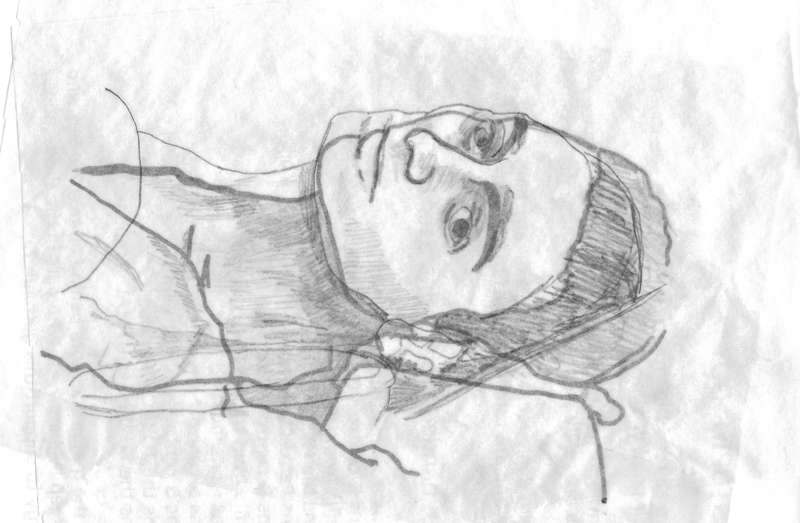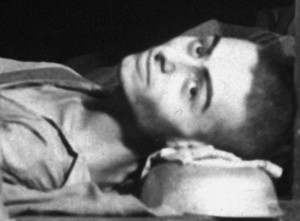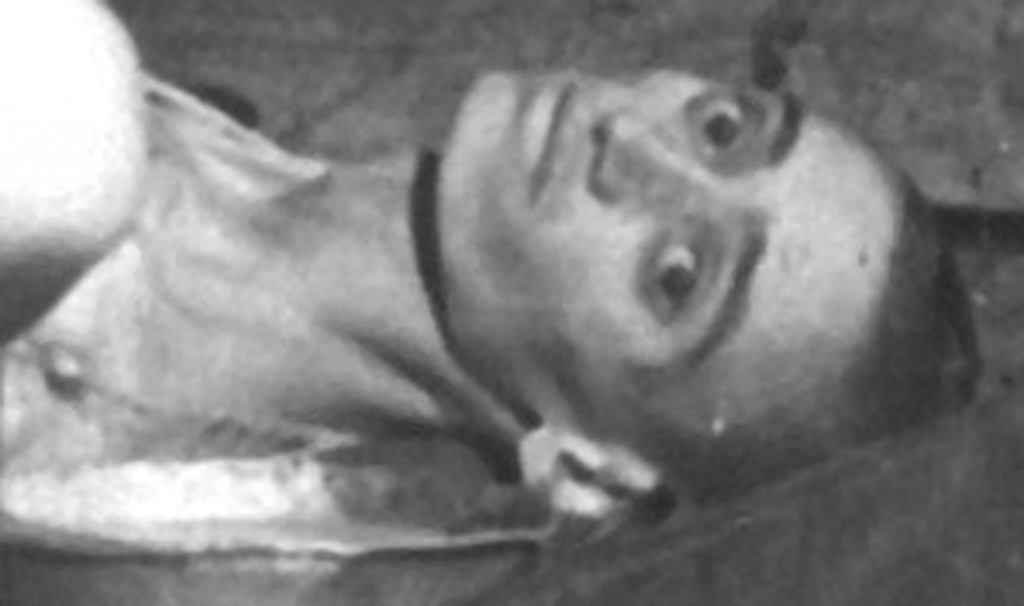Max Hamburger Says He Is the ‘Zombie Man’ in the Lower Bunk
Friday, January 4th, 2013
By Carolyn Yeager
Max Hamburger, a Jewish-Dutch psychiatrist, is the man in the above photograph taken in 2012. He is 92 years of age.
Hamburger has identified himself as the fourth figure in the bottom row of the famous Buchenwald photo — the figure he is pointing to with his thumb. He was 25 years-old in April 1945 when the camp was “liberated” by American troops. I want you to notice right away the space between Hamburger’s nose and upper lip — it is unusually long. The face of the young man in the famous photo does not have that long space, but just a normal, or even short, distance between nose and mouth. This is facial structure that doesn’t change, which is one clue that tells me he is not the same person.
Born on February 10, 1920 in Amsterdam, Max began the study of medicine in 1938 and, as best I can make out from Dutch language sources, he was arrested in 1942 because of his activism in the Dutch Resistance and sent to Westerbork, a camp for political prisoners in The Netherlands. He ended up in Auschwitz and then Buchenwald, he says, taking the usual route. According to this page, he was suffering from TB, and also malnutrition, when the famous photo he’s holding in his hands was taken.
The blurb on the Flicker page also says “he only survived Auschwitz because he could work as a medical assistant.” One has to ask about all those who didn’t work as a medical assistant, but also survived and went to Buchenwald … and survived Buchenwald too without being medical assistants! This is the kind of meaningless tripe we are always given to explain why people survived “death camps.” This page also says he now (in 2008) lives in Belgium and gives talks about his wartime experiences. In other words, he advertises himself as a holocaust survivor who is in the Famous Buchenwald Liberation Photo, the one that Elie Wiesel is in. (See final section below)
It should be noted that Nicholas Grüner is in this photo too; he is the first person on the left in the bottom row and the only one of the three mentioned who actually looks like himself, and is himself. Yet the labeling of this photograph at Yad Vashem Holocaust Memorial in Jerusalem (below) gives three possible identities for this figure: Gershon Blonder, Josef Reich or Nicholas (Miklos) Grüner … as if it were in doubt. The other two are not shown to be in doubt: the fourth figure on the bottom is Max Hamburger; the seventh figure in the 2nd row is Elie Wiesel. It’s clear to me that Yad Vashem will eventually deny that Nicholas Grüner is in the photo at all, and thus his claim that Elie Wiesel was not in the camp (or the photo) will be weakened. These people are nothing if not devious … and they accomplish their objective in a gradual manner. According to Yad Vashem …
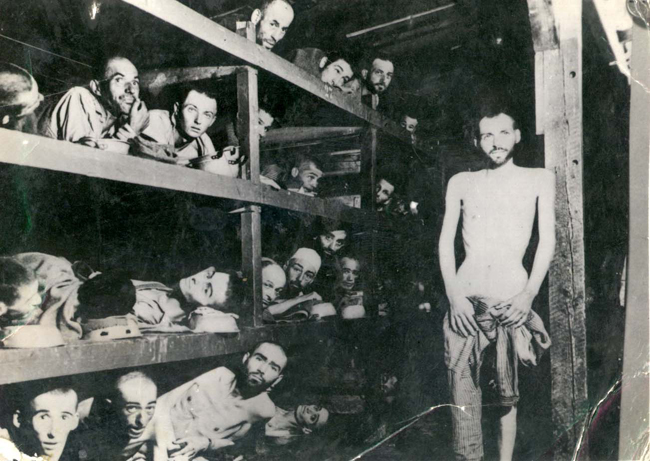 Second bunk:
Second bunk:
First from right– Elie Wiesel
Fourth from right:
• Herman Leefsma or
• Abraham Hipler or
• Berek Rosencajg or
• Zoltan Gergely
Fifth from right:
• Lajos Vartenberg (Yehuda Doron) or
• Yaakov Marton
Bottom bunk:
First from right – Max Hamburger
Third from right – Issac Reich
Fourth from right:
• Michael Miklos Nikolas Gruener or
• Gershon Blonder or
• Yosef Reich
Standing on the right: Chaim David Halberstam
Also notice that on the Flicker page the third man from left in the 2nd row up is not identified. That page went up in 2008. But on the Yad Vashem non-linkable “Anonymous No Longer” page for this particular photograph, this man is given two possible identities: Lajos Vartenburg (Yehuda Doron) or Yaakov Marton. On another Yad Vashem page with this picture, it reads:
On the second bunk from the bottom, third from left is Losh Wertenberg who later changed his name to Yehuda Doron, and according to other identification this man is Jeno Marton (identified by Yaakov Marton).
Screwy. Yad Vashem accepts whatever is sent to them because the memorial is by, for and about the Jewish people and they can do no wrong. However, we, of more discriminating nature, have to doubt that any of these names are correct … except Grüner.
Does Max Hamburger have a valid claim to be “the zombie” in the photograph?
It’s important to remember that this photo is recorded as having been taken on April 16, five days after the actual liberation. If this 4th person in the lower bunk had TB, would he still be lying in this barracks 5 days later or would he be in a hospital? If this were a hospital barracks, why do some of the men look so healthy? Elie Wiesel did not have TB, but, according to his own accounts, two days after liberation he ended up unconscious in the SS hospital with severe food poisoning. So Wiesel couldn’t be in this picture by his own statements!
Nicholas Grüner also had tuberculosis (TB) when this photo was taken. However, Grüner seems to think it was on the day of liberation, April 11, because he writes in his book Stolen Identity that as they were being marched to the camp entrance on that day (believing they were being taken somewhere to be killed), he managed to leave the line and run into the nearest barracks and jump into an empty bunk — which was this one. Later an American soldier came in and took a picture. Grüner was only 16 and had been living in the special children’s barracks, the same that Elie Wiesel says he was in. Grüner says his TB was not diagnosed until he was fully processed and he was then sent to a sanatorium in Switzerland, where he recovered.
I do not know if Max Hamburger has told a story about how his TB was treated. My information on him comes only from these few sources, mostly in the Dutch language. (Anyone who is able to translate the pdf article, please contact me.)
If Max Hamburger is the fourth man on the bottom row, he must also be the third man in the next row up (2nd row) because they are the same man. Yet he doesn’t say that — so something is very wrong with his claim.
Facial comparison of the two men
After printing the largest images of the two men’s faces, I did a careful tracing of each one. I then overlaid one on the other (in the drawing above) and determined:
- The nose, eyes and eyebrows, and head lined up perfectly one with another. This would not be possible if the two faces were not the same person.
- The mouth, while also remaining identical, is shifted upward on the “zombie” (as you look at the photo) and the entire lower face is widened and the jaw squared off. I’m not sure how this was accomplished, but on this particular figure it seems to be retouching paint. Look at that cauliflower ear, for example! The head is re-situated as laying flat on the bunk board (from the original pose of being propped up a few inches), necessitating a change in the relationship to the neck.
I thickened the outline of the “original” so it’s easy to tell which is which. You can compare the small photographic images of the two faces (left: 2nd row; right: bottom row) with the overlay to see how the very poor “retouching” job was done. Talk about sloppy work!
Why not just use a different person?
Why would they decide to insert the same man and then have to go to such lengths to make him look different? I think the answer to that is: several shots of this scene (with fewer live bodies than are there now) were taken on April 16, and only later it was decided to “fill in” the empty bunks by inserting figures from other negatives. For example, the two heads on the far left in the second and third row are clearly the same man with a slightly different twist of his head. The sleeping man, second from left in the second row, may be another view of the two men on the far left! Because why isn’t he facing the camera like all the others? The standing man is also a later addition inserted onto the photograph (see here).
As I pointed out before, this “Zombie copy” was also not gauged correctly size-wise — he is noticeably smaller than the men in the bunk right above his, when they should match up according to the laws of perspective.
More on Max Hamburger
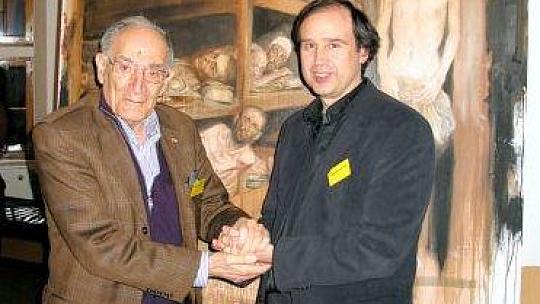 He is the son of a Dutch diamond polisher and baseball player, Hartog Hamburger. During a competition game in 1924, Hartog was hit on the head by a line drive when in the field. He died the next day as a result of the impact.
He is the son of a Dutch diamond polisher and baseball player, Hartog Hamburger. During a competition game in 1924, Hartog was hit on the head by a line drive when in the field. He died the next day as a result of the impact.
In February 2010, Max participated in the panel discussion of the Aachen Rabbi Mordechai drill in the German city of Aachen, along with the artist Máro and several others.
Both Máro (right) and his painting are shown in photo above, with Hamburger (left). According to the German news account:
“The discussion was all about the [then] 90-year-old Holocaust survivor Max Hamburger, whose speeches have gained great respect and […] the painting shown in the Castle Gallery by Máro, the image of a scene from the Buchenwald concentration camp.
“The artist explained the reasons which led him to the theme of the sufferings of Auschwitz. The series of pictures, which deals with the darkest chapter of German history, are meant to generate compassion and sensitivity for the suffering of the people depicted. […] Besides the issue of the Holocaust was also the art world itself, and the responsibility of the artist to contribute to the discussion of the Nazi terror, [which was] the focus of the [panel] discussion.”
Category Featured | Tags: Tags: artist Máro, Auschwitz, Buchenwald liberation photo, Elie Wiesel, Max Hamburger, Nicholas Gruner, Yad Vashem Memorial Museum, Yehuda Doron,
Social Networks: Facebook, Twitter, Google Bookmarks, del.icio.us, StumbleUpon, Digg, Reddit, Posterous.

